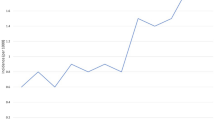Abstract
Purpose
This study evaluated possible predictors of long-term opioid usage among patients with ureteric stones who received ureteroscopy (URS) or shockwave lithotripsy (SWL). We also assessed opioid usage characteristics of URS and SWL recipients.
Materials and methods
This retrospective study used IQVIA PharMetrics® Plus for Academics administrative claims database from years 2006–2020 to identify patients with a diagnosis of kidney or ureteral stones who were treated with either SWL or URS. We performed unadjusted bivariate analyses to compare opioid use characteristics of URS and SWL recipients, and performed logistic regression to determine demographic and clinical factors associated with becoming a long-term opioid user.
Results
The study population consisted of opioid naive individuals having a diagnosis of a kidney stone who underwent URS (N = 9407) or SWL (N = 4894). About 6.7% (N = 964) of study subjects were long-term opioid users. Unadjusted bivariate associations showed that compared to non-long-term opioid users, long-term opioid users had significantly greater total days’ supply, total morphine milliequivalents (MME) supplied, and claims per month. A similar trend was observed for URS (vs. SWL) recipients. However, compared to SWL recipients, URS recipients had 14.3% (1.2–25.6%; p = 0.034) lower odds of becoming long-term users. Total days’ supply (OR: 1.041 (95% CI 1.030–1.052; p < 0.001) and total MME supplied (OR 1.001 (95% CI 1.000–1.001; p < 0.001) were significantly associated with long-term usage.
Conclusion
Higher total days’ supply and total MME supplied as well as SWL were identified as risk factors for becoming long-term opioid users.

Similar content being viewed by others
Abbreviations
- SWL:
-
Shockwave lithotripsy
- URS:
-
Ureteroscopy
- MME:
-
Morphine milliequivalents
References
Theisen K, Jacobs B, Macleod L (2018) The United States opioid epidemic: a review of the surgeon’s contribution to it and health policy initiatives. BJU Int 122(5):754–759. https://doi.org/10.1111/bju.14446
Hedegaard H, Warner M, Miniño AM (2017) Drug overdose deaths in the United States, 1999–2016. NCHS Data Brief 294:1–8
Califf RM, Woodcock J, Ostroff S (2016) A proactive response to prescription opioid abuse. N Engl J Med 374(15):1480–1485. https://doi.org/10.1056/NEJMsr1601307
Centers for Disease Control and Prevention and National Center for Injury Prevention and Control, 2020. Opioid overdose. Drug overdose deaths. https://www.cdc.gov/drugoverdose/data/statedeaths.html (June 15, 2020).
The Council of Economic Advisors, 2017. “The Underestimated Cost of the Opioid Crisis.”[ExecutiveSummary].https://www.whitehouse.gov/sites/whitehouse.gov/files/images/The%20Underestimated%20Cost%20of%20the%20Opioid%20Crisis.pdf (June 15, 2020).
Scales CD Jr, Smith AC, Hanley JM (2012) Prevalence of kidney stones in the United States. Eur Urol 62(1):160–165. https://doi.org/10.1016/j.eururo.2012.03.052
Pais VM Jr, Sites BD (2019) The association of nephrolithiasis with prescription opioid use. Clin Nephrol 91(4):231–236. https://doi.org/10.5414/CN109717
Leapman MS, DeRycke E, Skanderson M (2018) Variation in national opioid prescribing patterns following surgery for kidney stones. Pain Med 19(1):S12–S18. https://doi.org/10.1093/pm/pny125
NICE Guideline - Renal and ureteric stones: assessment and management: NICE (2019) Renal and ureteric stones: assessment and management. BJU Int. 2019;123(2):220–232. doi: https://doi.org/10.1111/bju.14654
Tchey DU, Ha YS, Kim WT (2011) Expectant management of ureter stones: outcome and clinical factors of spontaneous passage in a single institution’s experience. Korean J Urol 52(12):847–851. https://doi.org/10.4111/kju.2011.52.12.847
Shadman A, Bastani B (2017) Evaluation and management of kidney calculi. Iran J Kidney Dis 11(6):395–407
Zumstein V, Betschart P, Abt D (2018) Surgical management of urolithiasis—a systematic analysis of available guidelines. BMC Urol 18(1):25. https://doi.org/10.1186/s12894-018-0332-9
Centers for Medicare and Medicaid Services. (2018) Opioid Oral Morphine Milligram Equivalent (MME) Conversion Factors. Retrieved from https://www.cdc.gov/opioids/providers/prescribing/guideline.html.
Shafi S, Collinsworth AW, Copeland LA (2018) Association of opioid-related adverse drug events with clinical and cost outcomes among surgical patients in a large integrated health care delivery system. JAMA Surg 153(8):757–763. https://doi.org/10.1001/jamasurg.2018.1039
Lee LA, Caplan RA, Stephens LS (2015) Postoperative opioid-induced respiratory depression: a closed claims analysis. Anesthesiology 122(3):659–665. https://doi.org/10.1097/ALN.0000000000000564
Sobel DW, Cisu T, Barclay T (2018) A retrospective review demonstrating the feasibility of discharging patients without opioids after ureteroscopy and ureteral stent placement. J Endourol 32(11):1044–1049. https://doi.org/10.1089/end.2018.0539
Koo K, Winoker JS, Patel HD, Faisal F, Gupta N, Metcalf MR, Mettee LZ, Meyer AR, Pavlovich CP, Pierorazio PM, Matlaga BR (2021) Evidence-based recommendations for opioid prescribing after endourological and minimally invasive urological surgery. J Endourol 35(12):1838–1843. https://doi.org/10.1089/end.2021.0250
Hashem A, Ghobrial FK, Elbaset MA (2019) Efficacy of pethidine, ketorolac, and lidocaine gel as analgesics for pain control in shockwave lithotripsy: a single-blinded randomized controlled trial. Investig Clin Urol. 60(4):251–257. https://doi.org/10.4111/icu.2019.60.4.251
Ozkan F, Erdemir F, Erkorkmaz U (2012) Comparison of three different analgesic protocols during shockwave lithotripsy. J Endourol 26(6):691–696. https://doi.org/10.1089/end.2011.0004
Funding
This study was funded through the Urology Care Foundation Summer Medical Student Fellowship.
Author information
Authors and Affiliations
Corresponding author
Ethics declarations
Conflict of interest
All authors declare that they have no conflicts of interest.
Ethical approval
This study was deemed to not be human subjects’ research in accordance with our institutions IRB.
Informed consent
The UAMS IRB/Research Privacy Board approved the waiver of HIPAA authorization on 07/23/2020.
Additional information
Publisher's Note
Springer Nature remains neutral with regard to jurisdictional claims in published maps and institutional affiliations.
Special thanks to the Urology Care Foundation as well as the Arkansas Urologic Society for sponsoring this research.
The goal of this project was to examine opioid usage following commonly used procedures to treat kidney and ureteric stones. The hope is that physicians will be able to instead use opioid-free alternatives after these common treatments preventing a multitude of adverse preventable events.
Supplementary Information
Below is the link to the electronic supplementary material.
Rights and permissions
Springer Nature or its licensor holds exclusive rights to this article under a publishing agreement with the author(s) or other rightsholder(s); author self-archiving of the accepted manuscript version of this article is solely governed by the terms of such publishing agreement and applicable law.
About this article
Cite this article
James, S.T., Pandit, A.A., Machado, B. et al. Opioid usage differs significantly following ureteroscopy and shockwave lithotripsy, while development of long-term usage is positively correlated with total days’ supply and total MME supplied. Int Urol Nephrol 54, 2805–2811 (2022). https://doi.org/10.1007/s11255-022-03313-2
Received:
Accepted:
Published:
Issue Date:
DOI: https://doi.org/10.1007/s11255-022-03313-2



